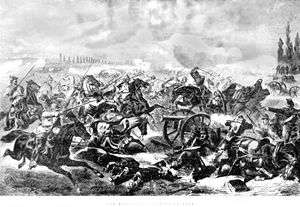Battle of Mars-la-Tour
| ||||||||||||||||||||||||||||||
The Battle of Mars-La-Tour was fought on 16 August 1870, during the Franco-Prussian War, near the town of Mars-La-Tour in northeast France. Two Prussian corps encountered the entire French Army of the Rhine in a meeting engagement and, surprisingly, successfully forced the Army of the Rhine to retreat into the fortress of Metz.
A cavalry patrol, the 1st Squadron of 1st Hanoverian Dragoon Regiment No. 9, led by Rittmeister [captain] Oskar von Blumenthal, discovered that 130,000 French troops, after suffering several defeats at the front, were attempting to escape from Metz to join with French forces at Verdun. This intelligence prompted General Prince Frederick Charles to send, on 16 August 1870, a grossly outnumbered group of 30,000 men of the advanced III Corps (of the 2nd Army) under General Constantin von Alvensleben with orders to cut them off. They located the French Army near Vionville, east of Mars-la-Tour. Despite being outnumbered more than four to one, III Corps routed the French and captured Vionville, blocking any further escape attempts to the west. Once prevented from retreat, the French inside Metz had no choice but to fight a battle that would see the last major cavalry engagement in Western Europe. III Corps, reinforced by X Corps under Konstantin Bernhard von Voigts-Rhetz, was devastated by incessant cavalry charges, losing over half its soldiers, while the French suffered equivalent numerical losses of 16,000 soldiers, but still held on to overwhelming numerical superiority.
On 16 August 1870, the French could have swept away the key Prussian defense and escaped. Two Prussian corps attacked the French advance guard, believing that it was the rearguard of the retreat of the French Army of the Meuse. Despite this misjudgment, the two Prussian corps held the entire French army for the whole day. The extraordinary confidence and tenacity of the Prussians prevailed over Bazaine's gross indecision.
Battle

The fighting started around Mars-la-Tour. This was a "soldier's battle", where the individual unit commanders and the fighting spirit of the troops on both sides would be the key to victory. Desperate street fighting ensued in the town, with heavy losses for both sides. Prussian infantry tried to overrun the French positions, but the French held them off. The Prussians were outnumbered four to one, but Bazaine never recognized this fact. He failed to send in his full force, while the Prussians committed every man and gun to the fight. With the invaluable advantage of immense self-confidence, the Prussians held on.
Von Bredow's "Death Ride"
The Battle of Mars-La-Tour is also notable for one of the very last successful cavalry charges of modern warfare.[1] Harassed by French artillery each time he redeployed his forces following a French attack, his infantry reserves exhausted and fearing that his shaky left flank was about to be charged by French cavalry, General von Alvensleben sent a message to the commander of the nearby 12th Cavalry Brigade, Major-General Friedrich Wilhelm Adalbert von Bredow, demanding that he silence French General François Canrobert's artillery and forestall a French cavalry charge with one of his own.

Noting that "it will cost what it will", von Bredow took his time to organize the brigade, consisting of the 7th Cuirassiers, 19th Dragoons, and 16th Uhlans. In what would become known as "Von Bredow's Death Ride", the cavalrymen rode out from Prussian lines at 14:00, von Bredow using the terrain and gun smoke to mask movements from French observers until the very last moment. Bursting into view some 1000 meters from the French lines, the Prussian cavalry charged into and broke through the French gun lines, causing widespread panic and scattering Canrobert's soldiers in all directions. Two brigades of French cavalry attempted to counter-charge into Bredow's flank and rear, but were partially dispersed by Canrobert's infantry, who gunned down any cavalrymen they could see without discrimination.
Having silenced the French artillery, neutralized the French cavalry, and panicked the French infantry, von Bredow's brigade managed to extricate itself and withdrew to their own lines. Of the 800 horsemen who had started out, only 420 returned.[1] Among the wounded from the 12th Brigade was Lieutenant Herbert von Bismarck, son of the Prussian chancellor Otto von Bismarck.
Aftermath
Analysis
The battle was a strategic victory for the Prussians. Bazaine had failed to make it to Verdun. In a short time, the Prussians trapped Bazaine in the city, and the siege of Metz ensued.
Von Bredow's death ride "was perhaps the last successful cavalry charge in Western European warfare".[1] Its success won it renown among military historians, which created a myth to the effect that for some decades 'Bredow’s achievement was the norm', that cavalry could still play a decisive role in battle in a modern war between equally equipped forces, and so cavalry units continued to be part of the armed forces of major European powers for the next half century.
Notes and references
- 1 2 3 Howard, Michael. The Franco-Prussian War. New York: Dorset Press. 1990, p. 157 [originally published in 1961]. ISBN 0-88029-432-9.
- "Mars-La-Tour – August 16th 1870". Hornchurch Wargames Club Official Home Page. Retrieved 30 December 2010.
- Galle, Martin-R. "Der Deutsch- Französische Krieg/The German- French War 1870 / 1871". Martins Guided Battlefield Tours. Archived from the original on 16 May 2008. Retrieved 30 December 2010.
- Compton's Home Library: Battles of the World CD-ROM
